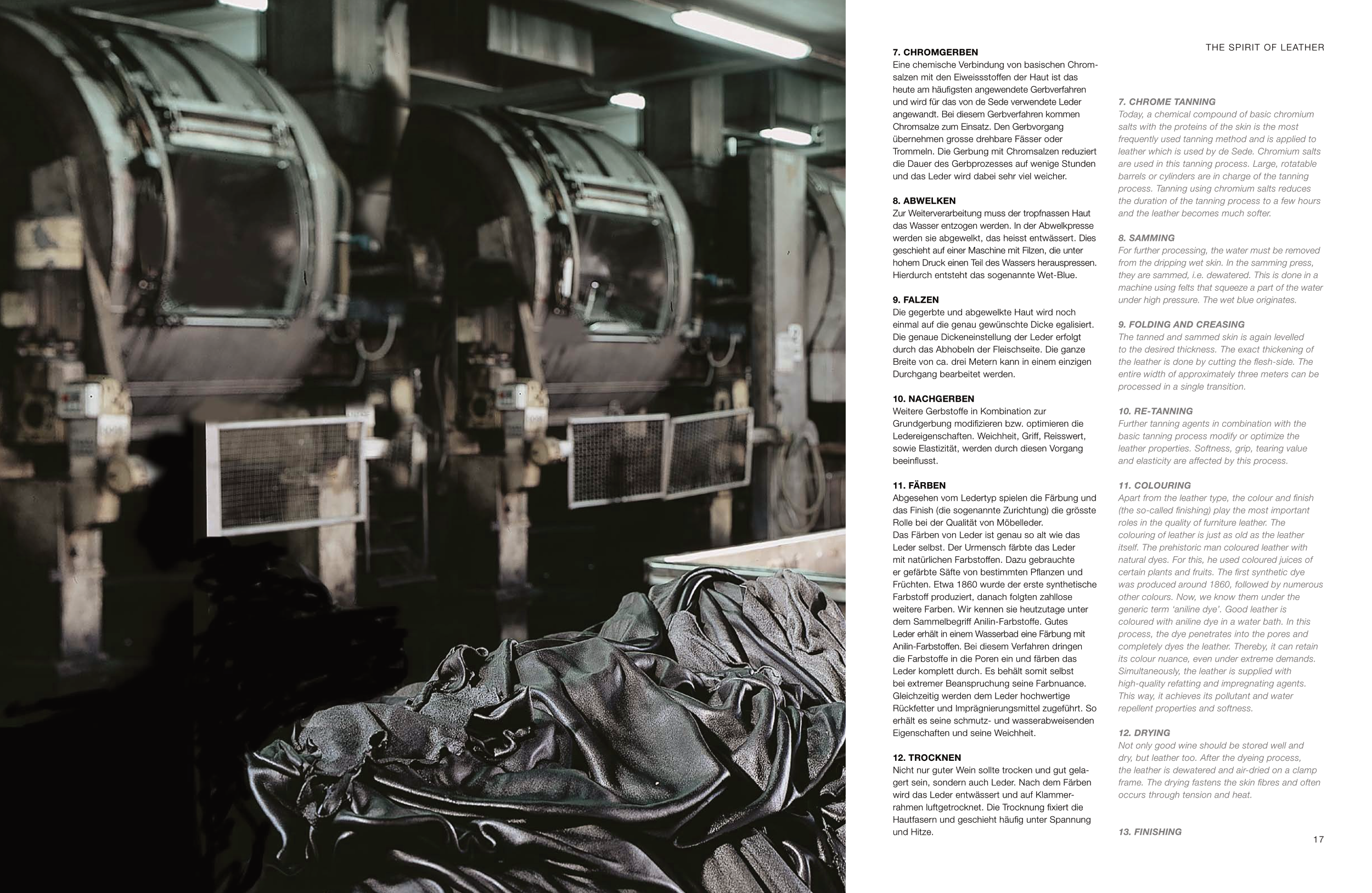16
17
THE SPIRIT OF LEATHER
7. CHROMGERBEN
Eine chemische Verbindung von basischen Chrom-
salzen mit den Eiweissstoffen der Haut ist das
heute am häufigsten angewendete Gerbverfahren
und wird für das von de Sede verwendete Leder
angewandt. Bei diesem Gerbverfahren kommen
Chromsalze zum Einsatz. Den Gerbvorgang
übernehmen grosse drehbare Fässer oder
Trommeln. Die Gerbung mit Chromsalzen reduziert
die Dauer des Gerbprozesses auf wenige Stunden
und das Leder wird dabei sehr viel weicher.
8. ABWELKEN
Zur Weiterverarbeitung muss der tropfnassen Haut
das Wasser entzogen werden. In der Abwelkpresse
werden sie abgewelkt, das heisst entwässert. Dies
geschieht auf einer Maschine mit Filzen, die unter
hohem Druck einen Teil des Wassers herauspressen.
Hierdurch entsteht das sogenannte Wet-Blue.
9. FALZEN
Die gegerbte und abgewelkte Haut wird noch
einmal auf die genau gewünschte Dicke egalisiert.
Die genaue Dickeneinstellung der Leder erfolgt
durch das Abhobeln der Fleischseite. Die ganze
Breite von ca. drei Metern kann in einem einzigen
Durchgang bearbeitet werden.
10. NACHGERBEN
Weitere Gerbstoffe in Kombination zur
Grundgerbung modifizieren bzw. optimieren die
Ledereigenschaften. Weichheit, Griff, Reisswert,
sowie Elastizität, werden durch diesen Vorgang
beeinflusst.
11. FÄRBEN
Abgesehen vom Ledertyp spielen die Färbung und
das Finish (die sogenannte Zurichtung) die grösste
Rolle bei der Qualität von Möbelleder.
Das Färben von Leder ist genau so alt wie das
Leder selbst. Der Urmensch färbte das Leder
mit natürlichen Farbstoffen. Dazu gebrauchte
er gefärbte Säfte von bestimmten Pflanzen und
Früchten. Etwa 1860 wurde der erste synthetische
Farbstoff produziert, danach folgten zahllose
weitere Farben. Wir kennen sie heutzutage unter
dem Sammelbegriff Anilin-Farbstoffe. Gutes
Leder erhält in einem Wasserbad eine Färbung mit
Anilin-Farbstoffen. Bei diesem Verfahren dringen
die Farbstoffe in die Poren ein und färben das
Leder komplett durch. Es behält somit selbst
bei extremer Beanspruchung seine Farbnuance.
Gleichzeitig werden dem Leder hochwertige
Rückfetter und Imprägnierungsmittel zugeführt. So
erhält es seine schmutz- und wasserabweisenden
Eigenschaften und seine Weichheit.
12. TROCKNEN
Nicht nur guter Wein sollte trocken und gut gela-
gert sein, sondern auch Leder. Nach dem Färben
wird das Leder entwässert und auf Klammer-
rahmen luftgetrocknet. Die Trocknung fixiert die
Hautfasern und geschieht häufig unter Spannung
und Hitze.
7. CHROME TANNING
Today, a chemical compound of basic chromium
salts with the proteins of the skin is the most
frequently used tanning method and is applied to
leather which is used by de Sede. Chromium salts
are used in this tanning process. Large, rotatable
barrels or cylinders are in charge of the tanning
process. Tanning using chromium salts reduces
the duration of the tanning process to a few hours
and the leather becomes much softer.
8. SAMMING
For further processing, the water must be removed
from the dripping wet skin. In the samming press,
they are sammed, i.e. dewatered. This is done in a
machine using felts that squeeze a part of the water
under high pressure. The wet blue originates.
9. FOLDING AND CREASING
The tanned and sammed skin is again levelled
to the desired thickness. The exact thickening of
the leather is done by cutting the flesh-side. The
entire width of approximately three meters can be
processed in a single transition.
10. RE-TANNING
Further tanning agents in combination with the
basic tanning process modify or optimize the
leather properties. Softness, grip, tearing value
and elasticity are affected by this process.
11. COLOURING
Apart from the leather type, the colour and finish
(the so-called finishing) play the most important
roles in the quality of furniture leather. The
colouring of leather is just as old as the leather
itself. The prehistoric man coloured leather with
natural dyes. For this, he used coloured juices of
certain plants and fruits. The first synthetic dye
was produced around 1860, followed by numerous
other colours. Now, we know them under the
generic term ‘aniline dye’. Good leather is
coloured with aniline dye in a water bath. In this
process, the dye penetrates into the pores and
completely dyes the leather. Thereby, it can retain
its colour nuance, even under extreme demands.
Simultaneously, the leather is supplied with
high-quality refatting and impregnating agents.
This way, it achieves its pollutant and water
repellent properties and softness.
12. DRYING
Not only good wine should be stored well and
dry, but leather too. After the dyeing process,
the leather is dewatered and air-dried on a clamp
frame. The drying fastens the skin fibres and often
occurs through tension and heat.
13. FINISHING


